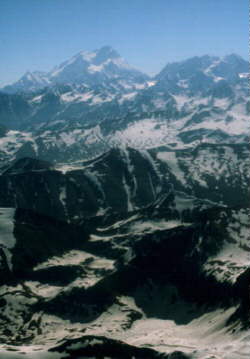 EOS,
Trans. Amer. Geophys. Union, 77, F692. Presented as poster
session,
17th December, 1996 Fall Meeting, American Geophysical Union, San
Francisco.
EOS,
Trans. Amer. Geophys. Union, 77, F692. Presented as poster
session,
17th December, 1996 Fall Meeting, American Geophysical Union, San
Francisco.
An Upwardly-Mobile Indentor? The Nanga Parbat Haramosh Massif viewed as a Crustal-Scale Pop-up Structure.
 EOS,
Trans. Amer. Geophys. Union, 77, F692. Presented as poster
session,
17th December, 1996 Fall Meeting, American Geophysical Union, San
Francisco.
EOS,
Trans. Amer. Geophys. Union, 77, F692. Presented as poster
session,
17th December, 1996 Fall Meeting, American Geophysical Union, San
Francisco.
M. A. Edwards, W. S. F. Kidd, (both at: Department of Geological Sciences, University at Albany, Albany, NY 12222); L. Seeber, (LDEO, Palisades, NY 10964); A. Pêcher, P. Le Fort, (both at: Institute Dolomieu, Grenoble, France); M. Riaz, Lehigh University, Bethlehem, PA 18015); M. Asif Khan (National Center of Exellence in Geology, Peshawar University, Pakistan)
The western Himalaya syntaxis [Fig 1] includes the Indian-plate Nanga Parbat Haramosh Massif (NPHM) [Fig 2]. The contact between collider India & the overthrust Kohistan-Ladakh series (KLS) is regionally termed the Main Mantle Thrust (MMT). It forms a plan-view, “oxbow” shape around NPHM, yet NPHM is not a relict promontory of India that has acted as a horizontal indenter and “bowed out” the visible MMT. This is recognised by the absence of appropriate deformation of the northern margin of the KLS. Pervasive lineation in NPHM is ~N-S, and sense of shear on the eastern margin is often dextral where recognised. Although this agrees with horizontal indentor model predictions, the broadly antiformal nature of NPHM allows the steep N-S foliation near the margins to be the result of rotation of the original, ~E-W, gently north-dipping MMT system about an axis ~parallel to the pervasive lineation. Therefore, the eastern margin and dextral shear sense, respectively, can be restored and recognised as top-to-south, MMT zone Himalayan thrust structures, largely unaltered. Observations now extending to seven main valleys confirm that there is no large brittle fault defining the eastern NPHM-KLS contact; the contact is essentially unmodified MMT. The antiformal nature of the massif is illustrated by the degree of apparent exhumation. Within NPHM, exhumation of the central portions of the massif (e.g. Nanga Parbat) has formed a complete window through Indian plate cover sequence schist and gneiss (garnet-staurolite grade) into basement gneiss (sillimanite grade ±granulite facies, cordierite-bearing anatectic segregations). This exhumation has been accommodated in part by large ductile and brittle shear zones within SE NPHM. The Rupal Shear Zone is a wide belt of ~N-S trending orthogneiss showing a pervasive, west side up with dextral shear S-C fabric and overprinting lineation. Closer to the eastern margin, the Churit Fault in lower Tarshing valley juxtaposes sillimanite (?) grade orthogneiss in the west over staurolite grade metapelites in the east, but lacks significant ductile overprinting of regional N-S lineation. Near Raikot, the original MMT contact of the western margin is largely obscured by east-over-west thrusting with some overprinting the regional ~N-S lineation. Qualitative changes in the relative development of some fault and shear zone features may indicate diminishing strain to the north. Within NPHM and in Kohistan, late, NW-vergent structures dominate (young pegmatitic dyke sets, fault propagation folds, antithetic faults) and are suggestive of an asymmetric pop-up or flower structure. The NW-vergence in NPHM late brittle structures is consistent with the direction of axes of maximum compression derived from brittle fault kinematics in both crystalline and Quaternary rocks near and west of the Raikot fault. Our evidence confirms and strengthens the view that NPHM is an asymmetrical antiformal structure, verging NW.
Captions and access to photographs
Is there any significant brittle faulting on the eastern NPHM margin?
Structural Map of Eastern Margin of Nanga Parbat Massif
Is there any evidence for tectonic denudation of the Nanga Parbat massif?
Fig. 1. Regional geological setting of the Nanga Parbat-Haramosh massif [NPHM]
Fig. 2. Outline geological map of the Nanga Parbat-Haramosh Massif (revised 1997) (original version)
1997 AGU Abstract - Structural Geology of the Southwestern Margin of Nanga Parbat
Contribution to the Nanga Parbat project, funded by the National Science Foundation Continental Dynamics Program.